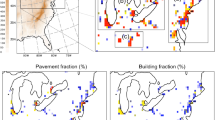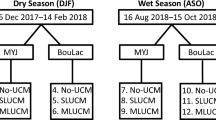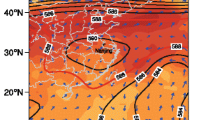Abstract
Urban surface temperature is hazardously higher than surrounding regions (so-called urban heat island effect UHI). Accurately simulating urbanization-induced temperature hazard is critical for realistically representing urban regions in the land surface-atmosphere climate system. However, inclusion of urban landscapes in regional or global climate models has been overlooked due to the coarse spatial resolution of these models as well as the lack of observations for urban physical properties. Recently, National Aeronautics and Space Administration (NASA) Earth Observing System (EOS) Moderate Resolution Imaging Spectroradiometer (MODIS) observations illustrate important urban physical properties, including skin temperature, surface albedo, surface emissivity, and leaf area index, It is possible to identify the unique urban features globally and thus simulate global urban processes. An urban scheme is designed to represent the urban-modified physical parameters (albedo, emissivity, land cover, roughness length, thermal and hydraulic properties) and to include new, unique physical processes that exist in urban regions. The urban scheme is coupled with National Center for Atmospheric Research (NCAR) Community Land Model Version 2 (CLM2) and single column coupled NCAR Community Atmosphere Model CAM2/CLM2 to assess the mechanisms responsible for UHI. There are two-steps in our model development. First, satellite observations of albedo, emissivity, LAI, and in situ observed thermal properties are updated in CLM2 to represent the first-order urban effects. Second, new terms representing the urban anthropogenic heat flux, storage heat flux, and roughness length are calculated in the model. Model simulations suggest that human activity-induced surface temperature hazard results in overlying atmosphere instability and convective rainfall, which may enhance the possibility of urban flood hazard.










Similar content being viewed by others
Notes
Previously, urban effects have been primarily indicated by urban-to-rural surface air temperature differences, namely the Urban Heat Island (UHI) effect (Oke 1976; Landsberg 1975). In this paper, satellite land surface skin temperature is examined. Skin temperature, retrieved from upward longwave radiation, is closely related to the surface radiative properties and is more suitable than the conventional surface air temperature in studies of climate change (Jin et al. 1997; Jin and Dickinson 1999, 2000, 2002), since the latter has shortcomings such as irregular spatial coverage, site changes, and coarse resolutions (Karl et al. 1988).
References
Arnfield AJ (1982) An approach to the estimation of the surface radiative properties and radiation budgets of cities. Phys Geogr 3:97–122
Bornstein R, Lin Q (2000) Urban heat islands and summertime convective thunderstorms in Atlanta: Three case studied. Atmos Env 34:507–516
Burian SJ, Shepherd JM (2005) Effects of urbanization on the diurnal rainfall pattern in Houston: Hydrological Processes: special issue on rainfall and hydrological processes 19:1089–1103
Burian SJ, Shepherd JM, Hooshialsadat P (2004) Urbanization impacts on Houston rainstorms. In: James W (ed) Innovative Modeling of Urban Water Systems. BPR, 1–22
Dai Y, Zeng X, Dickinson RE, Baker I, Bonan G, Bosilvich M, Denning S, Dirmeyer P, Houser P, Niu G, Oleson K, Schlosser A, Yang Z (2003) The Common Land Model (CLM). Bull Am Meteorol Soc 84:1013–1023
Friedl MA, McIver DK, Hodges JC, Zhang Y, Muchoney D, Strahler AH, Woodcock CE, Gopal S, Schneider A, Cooper A, Baccini A, Gao F, Schaaf CB (2002) Global land cover mapping from MODIS: Algorithms and early results. Remote Sensing Environ 83:287–302
Grimmond CSB, Oke TR (1999) Heat storage in urban areas: Local-scale observations and evaluation of a simple model. J Appl Meteorol 38:922–940
Hansen J, Ruedy R, Sato M, Imhoff M, Lawrence W, Easterling D, Peterson T, Karl T (2001) A closer look at United States and global surface temperature change. J Geophy Res 106(D20):23, 947–23, 963
IPCC, Intergovernmental Panel on Climate Change, Climate Change (2001) The Scientific Basis. Contribution of working group 1 to the Third Assessment Report of the Intergovernmental Panel on Climate Change, edited by Houghton JT et al., 881 pp, Cambridge Univ. Press, New York
Jauregui E (1997) Aspects of urban human biometeorology, Int J Biometeorol 40:58–61
Jin M (2004) Analyzing skin temperature variations from long-term AVHRR. Bull Am Meteor Soc 587–600
Jin M, Dickinson RE, Vogelmann AM (1997) A comparison of CCM2/BATS skin temperature and surface air-temperature with satellite and surface observations. J Climate 10:1505–1524
Jin M, Dickinson RE (1999) Interpolation of surface radiation temperature measured from polar orbiting satellites to a diurnal cycle. Part 1: without clouds. J Geophy Res 104: 2105–2116
Jin M, Dickinson RE (2000) A generalized algorithm for retrieving cloudy-sky skin temperature from satellite thermal infrared radiances. J Geophy Res D22:27037–27047
Jin M, Dickinson RE (2002) New observational evidence for global warming from satellite. Geophys Res Lett 29(10), http://dx.doi.org/10.1029/2001GL013833
Jin M, Shepherd JM (2005) On including urban landscape in land surface mode—How can satellite data help? Bull Am Meteor Soc 86(5):681–689
Jin M, Liang S (2006) Improving land surface emissivity parameter of land surface model in GCM. J Climate 19:2867–2881
Jin M, Dickinson RE, Zhang D (2005a) The footprint of urban climate change through MODIS. J Climate 18(10):1551–1565
Jin M, Shepherd JM, King MD (2005b) Urban aerosols and their interaction with clouds and rainfall: A case study for New York and Houston. J Geophy Res 110: D10–S20, doi:10.1029/2004JD005081
Karl TR, Diaz HF, Kukla G (1988) Urbanization: Its detection and effect in the United States Climate Record, J Climate 1:1099–1123
King MD, Menzel WP, Kaufman YJ, Tanré D, Gao BC, Platnick S, Ackerman SA, Remer LA, Pincus R, Hubanks PA (2003) Cloud and aerosol properties, precipitable water, and profiles of temperature and humidity from MODIS, IEEE Trans. Geosci Remote Sens 41:442–458
Kunkel KE, Changnon SA, Reinke BC, Arritt RW (1996) The July 1995 Heat Wave in the Midwest: A Climatic Perspective and Critical Weather Factors. Bull Am Meteorol Soc 77(7):1507–1518
Macdonald RW, Griffiths RF, Hall DJ (1998) An improved method for estimation of surface roughness of obstacle arrays. Atmos Environ 32:1857–1864
Mölders N, Olson MA (2004) Impact of urban effects on precipitation in high latitudes. J Hydrometeor 5:409–429
Olson KW et al (2004) Technical Description of the Community Land Model (CLM), NCAR Technical Note NCAR/TN-461+STR, National Center for Atmospheric Research, Boulder, Colorado 80307–3000, 173 pp
Oke TR (1976) City size and the urban heat island. Atmos Environ 7:769–779
Oke TR (1982) The energetic basis of the urban heat island, Quart J Roy Meteor Soc 108:1–24
Otte TL, Lacser A, Dupont S, Ching JK-S (2004) Implementation of an urban canopy parameterization in a mesoscale meteorological model, J App Met 43(11):1648–1665
Orville RE, Huffines G, Nielsen-Gammon J, Zhang RY, Ely B, Steuger S, Phillips S, Allen S, Read W (2001) Enhancement of cloud-to-ground lightning over Houston, Texas. Geophys Res Lett 28(13):2597–2600
Raupach M (1992) Drag and drag partition on rough surfaces. Bound-Layer Meteor 60:375–395
Rosenfeld D (2000) Suppression of rain and snow by urban air pollution. Science. 287:1793–1796
Schaaf CB, Gao F, Strahler AH et al (2002) First Operational BRDF, Albedo and Nadir Reflectance Products from MODIS. Remote Sens Environ 83(1):135–148
Shepherd JM (2005) A Review of Current Investigations of Urban-Induced Rainfall and Recommendations for the Future. Earth Inter 9(12):1–27
Schneider A, Friedl MA, McIver DK, Woodcock CE (2002) Mapping urban areas by fusing multiple sources of coarse resolution remotely sensed data. Photogramm Eng Remote Sens 69:1377–1386
Voogt JA, Grimmond CSB (2000) Modeling surface sensible heat flux using surface radiative temperatures in a simple urban area. J Appl Meteorol 39:1679–1699
Wan Z, Dozier J (1996) A generalized split-window algorithm for retrieving land-surface temperature from space. IEEE Trans Geo Remote Sens 34:892–904
Acknowledgments
We thank the Year 2003 NASA GSFC DDF, EOSIDS. and the TRMM program for supporting the initial study of this work. We also thank Robert E. Dickinson for extremely useful discussion on urban roughness length. Thanks go to our NASA Academy summer student, Mr. Miguel Roman-Colon, who helped assess early versions of the MODIS products.
Author information
Authors and Affiliations
Corresponding author
Rights and permissions
About this article
Cite this article
Jin, M., Shepherd, J.M. & Peters-Lidard, C. Development of a parameterization for simulating the urban temperature hazard using satellite observations in climate model. Nat Hazards 43, 257–271 (2007). https://doi.org/10.1007/s11069-007-9117-2
Received:
Accepted:
Published:
Issue Date:
DOI: https://doi.org/10.1007/s11069-007-9117-2




